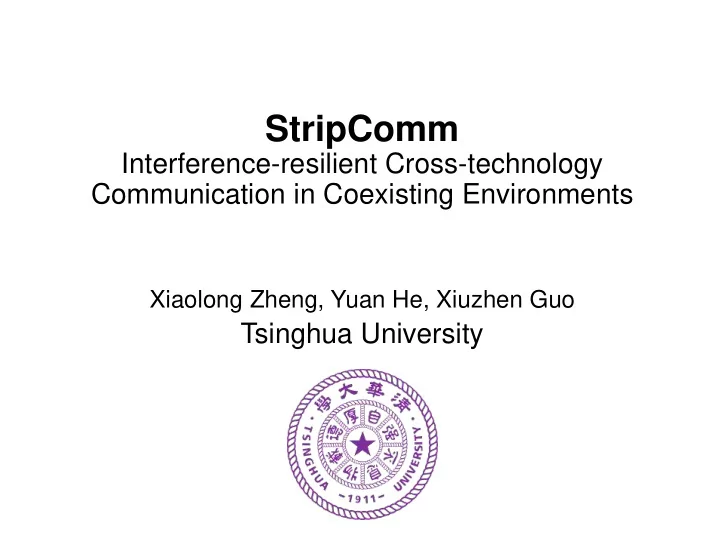

StripComm Interference-resilient Cross-technology Communication in Coexisting Environments Xiaolong Zheng, Yuan He, Xiuzhen Guo Tsinghua University
Wireless Coexistence Heterogeneous devices coexist Contention for the shared frequency resource Cooperation for smarter service 2
Interconnect Various Technologies Cross-technology Communication (CTC) • Emerging technique • Enable direct communication between heterogeneous wireless technologies Channel 1 2 3 4 5 6 7 8 9 10 11 12 13 WiFi IEEE 802.11 Frequency (MHz) 2412 2437 2462 22MHz Channel Spacing 5MHz ZigBee IEEE 802.15.4 Frequency (MHz) 2405 2480 Channel 11 Channel 26 Bluetooth IEEE 802.15.1 Frequency (MHz) 2402 2480 1MHz 3
Existing CTC Packet-level CTC • Manipulating the packet amplitude, packet timing to build the side channel. • Require radio silence CTC WiZig Zzz... Multiple energy levels Radio silence for CTC Zzz... Energy modulation: Packet presence 1 Packet absence 0 4
Motivation However… • Wireless coexistence • Hard to keep radio silence for all devices Coexisting interference will …? Coexisting Interference CTC Zzz... Radio silence Coexisting for CTC Interference Zzz... Energy modulation: Packet presence 1 Packet absence 0 5
Motivation We study the performance of WiZig in an apartment • A CTC WiFi sender, a CTC ZigBee receiver • Uncontrolled ambient WiFi devices High SER Low Throughput SNR=CTC signal strength / channel noise + coexisting interference 6
Motivation Insight: • CTC rely on packet presence/absence, which is easily corrupted by the interference. f(x) f N (x) f S (x) T 1 T 2 T 3 T 4 T 5 Time x 0 a/2 a 1 1 0 0 1 TX Symbol (a) f(x) f N (x) f S (x) 802.11 Sender 802.15.4 Receiver x 0 a/2a (without interference) (b) 1 1 0 0 1 RX symbol f(x) f N (x) f S,I (x) x Interference 0 a/2a' (c) f(x) f N (x) 802.15.4 Receiver f S (x) (with interference) f I (x) 1 1 0 1 1 RX symbol x 0 a/2a a I (d) Interference leads to the false appearance of CTC packet presence 7
Outline Background & Motivation Design of StripComm • Interference-resilient coding • Interference-aware decoding Evaluation Conclusion 8
Design Goal: Interference-resilient CTC that achieves high throughput with low error rate even under coexisting interference. StripComm Sender StripComm Receiver Link Layer Link Layer Data Stream Data Stream StripComm PHY Layer StripComm PHY Layer Logical Channel Interference Symbol Estimation Demodulation 1 1 0 0 1 0 P I , L, I Filtered RSS Parameter Interference Selection Cancelation T* T, a Symbol Parameter Modulation Estimation Segments Packet TX RSS Scheduling Segmentation Schedule RSS Physical Channel PHY Layer PHY Layer Interference-aware decoding Interference-resilient coding 9
Interference-resilient coding Manchester Coding • Use both packet presence (high) and absence (low) to encode a symbol • Symbol 1: high then low • Symbol 0: low then high Energy signal Interference Amplitude K L 1 1 1 0 1 1 T AM CTC Amplitude L 1 0 0 0 1 1 T StripComm 10
Interference-resilient coding StripComm defines a packet preamble to specify the start of a CTC packet StripComm sender controls the packet length and transmission timing, based on the encoded CTC symbols. 11
Interference-aware decoding Find falling and rising edges, and decode symbols by the “high then low” and “low then high” patterns of the RSS sequence. However, the segments’ amplitude, length, interval can be corrupted. Overlapped Inserted 12
Interference-aware decoding Use self similarity to strip interference from the interested signal 50% High, 50% Low T H = T L 13
Interference-aware decoding Use self similarity to strip interference from the interested signal ISI i = T/2 ISI i = T T i = T i+1 14
Interference-aware decoding Use self similarity to strip interference from the interested signal 𝑏 𝑗 ≈ 𝑏 𝑗+1 𝑏 ≈ 𝜀 𝑗+1 𝑏 𝜀 𝑗 𝑏 𝑗 ≈ 𝑏 𝑗+1 𝑏 ≈ 𝜀 𝑗+1 𝑏 𝜀 𝑗 Packets experience similar channel conditions in a short time, 𝑏 ≈ 𝜀 𝑗+1 𝑏 𝑏 𝑗 ≈ 𝑏 𝑗+1 𝜀 𝑗 15
Interference-aware decoding Use self similarity to strip interference from the interested signal Decode the symbols from the processed RSS sequence (blue sequences) 16
Outline Background & Motivation Design of StripComm • Interference-resilient coding • Interference-aware decoding Evaluation Conclusion 17
Evaluation Setup • ZigBee: TelosB (raido: cc2420) • WiFi: commercial laptops, D-ITG traffic generator USRP/N210 Environments: • Office and lab 18
Overall Performance Throughput • When Symbol Error Rate (SER) < 0.01 WiFi -> ZigBee: 1.1Kbps, 6.5X higher than the state-of-the-art ZigBee - > WiFi: 77,8bps, 3.3X higher than the state-of-the-art 34.9 times FreeBee 31.5 6.5 times WiZig WiFi->ZigBee 167.8 StripComm 1.1K 5.3 times FreeBee 14.6 3.3 times 23.7 WiZig ZigBee->WiFi StripComm 77.8 Throughput (bps) 10 30 100 200 1000 19
Performance under Interference SER vs. Interference rate (packets/second) Packet size = 1000bytes Packet size = 50bytes SER (1) With interference rate increases, SER increases; (2) Stripcomm has a low SER; (3) Interference-resilient coding can conquer partial interference; (4) Interference-aware decoding can solve most of the interference. 20
Performance under Interference Throughput vs. Interference rate (packets/second) (1) With interference rate increases, throughput decreases; (2) Stripcomm has relative stable throughput due to the low SER; (3) Interference-aware decoding significantly improves the throughput. Throughput Packet size = 1000bytes Packet size = 50bytes 21
Performance vs. Distance Distance between the sender and receiver StripComm from WiFi to ZigBee StripComm from ZigBee to WiFi (1) From WiFi to ZigBee, throughput decreases slightly; (2) From ZigBee to WiFi, throughput decreases significantly; (3) StripComm from ZigBee to WiFi is more sensitive to distance than from WiFi to ZigBee due to the high TX power of WiFi. 22
Conclusion We present StripComm, an interference-resilient CTC. We design the interference-resilient coding method and the interference-aware decoding method. We evaluate StripComm under various experimental settings. • Results demonstrate StripComm can achieve the throughput up to 1.1Kbps , 6.5X higher than the state-of-the-art. 23
StripComm Interference-resilient Cross-technology Communication in Coexisting Environments Thank you! Q & A
Recommend
More recommend